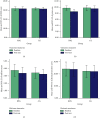Short-Term Effects of Strengthening Exercises of the Lower Limb Rehabilitation Protocol on Pain, Stiffness, Physical Function, and Body Mass Index among Knee Osteoarthritis Participants Who Were Overweight or Obese: A Clinical Trial
- PMID: 34975349
- PMCID: PMC8716196
- DOI: 10.1155/2021/6672274
Short-Term Effects of Strengthening Exercises of the Lower Limb Rehabilitation Protocol on Pain, Stiffness, Physical Function, and Body Mass Index among Knee Osteoarthritis Participants Who Were Overweight or Obese: A Clinical Trial
Abstract
Background: Osteoarthritis (OA) of the knee is defined as a progressive disease of the synovial joints and is characterized by wear and tear of the cartilage and underlying bone. This study aimed to determine the short-term effects of the lower limb rehabilitation protocol (LLRP) on pain, stiffness, physical function, and body mass index (BMI) among knee OA participants who were overweight or obese. Methodology. A single-blinded randomized controlled trial of one-month duration was conducted at Rehmatul-Lil-Alameen Postgraduate Institute, Lahore, Pakistan. Fifty overweight or obese participants with knee OA were randomly divided into two groups by a computer-generated number. Participants in the rehabilitation protocol group (RPG) were provided with leaflets explaining the strengthening exercises of the LLRP and instruction of daily care (IDC), while the participants in the control group (CG) were provided with leaflets explaining the IDC only for a duration of four weeks. The primary outcome measures were the Western Ontario and McMaster Universities Osteoarthritis Index (WOMAC) scores for pain, stiffness, and physical function. The secondary outcome measures were BMI, exercise adherence, and patients' satisfaction assessed by using the numeric rating scale ranging from 0 to 10. The paired-sample t-test was used to analyze the differences within groups from baseline to posttest evaluations. The analysis of variance 2 × 2 factor was used to analyze the differences in BMI, knee pain, stiffness, and physical function between the groups.
Results: Participants in the RPG and CG reported a statistically significant reduction in knee pain and stiffness (p ≤ 0.05) within the group. The reduction in the scores of knee pain was higher in participants in the RPG than that in participants in the CG (p=0.001). Additionally, participants in the RPG reported greater satisfaction (p=0.001) and higher self-reported exercise adherence (p=0.010) and coordinator-reported exercise adherence (p=0.046) than the participants in the CG.
Conclusion: Short-term effects of the LLRP appear to reduce knee pain and stiffness only, but not physical function and BMI.
Copyright © 2021 Muhammad Tariq Rafiq et al.
Conflict of interest statement
The authors declare no conflicts of interest.
Figures


References
-
- Miller M. D., Thompson S. R. DeLee & Drez’s Orthopaedic Sports Medicine E-Book . Amsterdam. Netherlands: Elsevier Health Sciences; 2014.
-
- Podlipská J., Koski J. M., Liukkonen E. Non-invasive semi-quantitative and quantitative ultrasonography findings in knee osteoarthritis: preliminary study. Osteoarthritis and Cartilage . 2014;22:S278–S279. doi: 10.1016/j.joca.2014.02.519. - DOI
Publication types
MeSH terms
LinkOut - more resources
Full Text Sources
Medical

